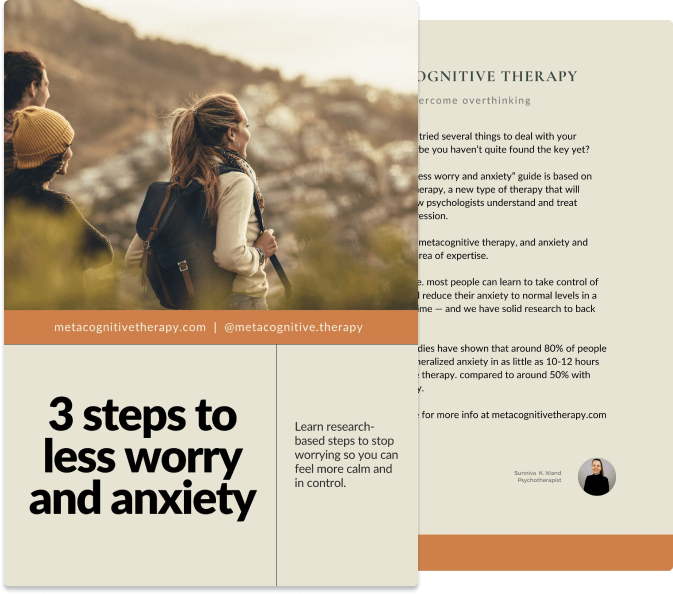Dealing with compulsive thoughts and OCD: a metacognitive perspective

Download our best tips on reducing anxiety and worrying
Learn three powerful metacognitive therapy steps to stop the worry cycle, reduce anxiety, and feel calmer in everyday life.


If you're plagued with compulsive, unwanted thoughts, you've come to the right place. First off, know that it's possible to have invasive and unpleasant thoughts without developing obsessive-compulsive disorder (OCD). So why do some people develop OCD, and others don't?
Unpleasant thoughts are common, and don’t necessarily lead to anxiety
Research shows that on average, we have about 70,000 thoughts each day. And sometimes, some of these thoughts that arise can appear as 'sick' and create judgment and discomfort.
But you're not alone in this. It’s normal to get uncomfortable thoughts from time to time. For example, research shows that about 80-90% of the population has had thoughts of injuring their own mother with a knife… but this does not mean that 80-90% of us have actually wanted to hurt our own mother with a knife.
Most people who have had this particular thought might have felt uncomfortable and a little disturbed, but the majority went on with their lives without dwelling on it. In a small proportion of the population, such a thought can cause so much discomfort and disgust that they try to force it away or begin to dwell on things like, 'What does this thought say about me as a person?', or 'What if I thought this because I actually want to stab my mom?”.
Who develops issues with compulsive thoughts and OCD?
People who believe that certain thoughts are important and have special power are more likely to develop OCD. We call these beliefs fusion-beliefs, and you can read more about them here.
People essentially develop OCD when they believe they have to control or rid themselves of certain thoughts in order to keep themselves and their surroundings safe. This leads to over-engaging with triggering thoughts, which prevents them from discovering that their thoughts are in fact not dangerous or powerful, but just random, uncomfortable brain activity.
People who move on and treat uncomfortable thoughts like any other random thoughts tend to not develop a problem, versus those who dwell on the thoughts, devoting attention and time to them.

Download our best tips on reducing anxiety and worrying
Learn three powerful metacognitive therapy steps to stop the worry cycle, reduce anxiety, and feel calmer in everyday life.
How does it work?
The more cognitive capacity you spend on a thought, the more likely it is that the thought will stick, and the more importance our brain will place on this thought.
Imagine the following scenario: Two new fathers go down a hill, each pushing a stroller. Both fathers experience a thought: “What if I suddenly let go of the stroller?” While this is a scary and unpleasant thought for both fathers, they each relate differently to the thought.
One father finds the thought strange, but he doesn't dwell on it and moves on quickly. The other father finds the thought uncomfortable, and instead of moving past it, he begins to ruminate: 'What's wrong with me that I thought this', 'Am I a bad father', 'Does this mean I don’t love my baby?'
He becomes very concerned that he should never get this thought again. When the thought still appears, he tries to push it away as hard as he can. He starts to wonder if the more he thinks about it, the more likely he'll be to actually let go of the stroller. Because he's worried about having a similar thought again, he decides to change the walking route next time to avoid the hill. He also starts looking for signs of whether he really is a good father or not. As the thought continues to haunt him and expand to all aspects of walking with a stroller, he opts out of going for walks at all.
It's clear that it is not the thought itself that's the problem. After all, both fathers got the same 'let-go-of-the-stroller' thought. What made the difference was the way they chose to deal with the unpleasant thought.
We can’t control which thoughts appear and when they'll come, but we can choose how we relate to them.
Takeaways for compulsive thoughts
If, like the father in the story, you are struggling with intrusive and unpleasant thoughts, remember the following:
- A thought is just a thought. It can be uncomfortable, but not dangerous.
- Your thoughts are not the problem —— the problem is you they are important and require action.
- Avoidance is one of the strongest sustaining factors for anxiety, across all anxiety disorders.
- Thought suppression does not work well, and tends to backfire.
- It is impossible to control which thoughts pop into your mind.
- You choose which thoughts you want to spend time on and what you focus your attention on.
- There is a real difference between trying to suppress a thought, and choosing to leave the thought alone and shifting the focus to something else.
- Ruminating over why you get unpleasant thoughts is wasted energy. You likely won't find the answers, and instead, you'll maintain negative thoughts and anxiety levels.
The next time an unwanted thought arises, try not to judge yourself (remember that everyone has disturbing thoughts sometimes) and allow it to pass naturally as you continue on with your day.
If you're having trouble breaking out of the cycle of worry, start by reading this article on seven tips to stop worrying.



